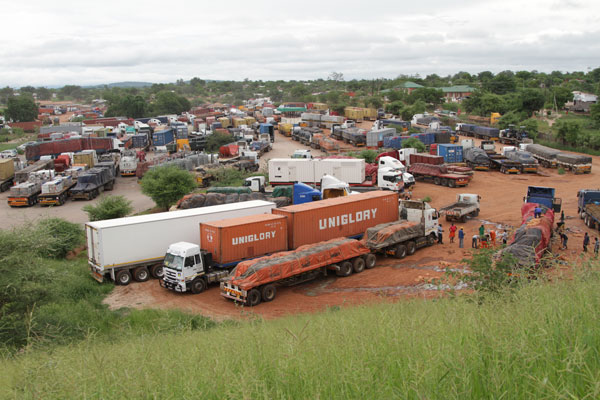
In Southern Africa, the transport sector is very viable because of economic development in the region according to World Bank Report 2016, the trucking business created employment for more than 100 000 people in Southern Africa.
BY PATSON CHAPEYAMA
Four main trade corridors link Zambia and the South East Democratic Republic of Congo to the sub region and overseas markets.
These are Dar-es-Salaam, Walvis Bay, Beira, and the north-south corridor through Durban. The north-south corridor serves a dual purpose: First, it serves as an intra-regional trade route between Zambia (and further South East, the Democratic Republic of Congo and western Malawi) and its neighbours, Botswana, Zimbabwe and South Africa, and as a link to the port of Durban for overseas imports and exports. From south to north, the two main border crossing points are Beitbridge between South Africa and Zimbabwe and Groblers Bridge/Martins Drift between South Africa and Botswana.
Beitbridge is the busiest border post in the region, handling as many as 500 trucks per day, whereas volumes through Martins Drift are about half that number. Freight demand in Zambia has been rising rapidly with the opening of new mines, the increase of copper prices, and the growth of the economy. In 2015 an estimated 1,6 million tonnes were exported, and 3,3 million tonnes were imported. The main exports from Zambia are mineral and agricultural commodities. The main imports, volume wise, were mineral products, chemicals, heavy mining equipment, and manufactured goods. However, value wise, Zambia’s main imports were machinery and mechanical appliances, fuels, electrical machinery, and vehicles.
Although the port of Beira in Mozambique is closer than Durban for most Zambian shippers, Durban is more convenient as it can be accessed directly by reliable road infrastructure and with channel-dredging equipment. Durban’s port equipment and lower maritime transport rates make it also attractive for Zambian shippers.
Durban is the largest port in the area, accounting for at least three quarters of the total capacity provided by the various ports serving the corridors in the sub region. The Durban–Lusaka corridor route is then the most utilised corridor for Zambia. The above information makes the trucking business viable since most of the goods are transported using road networks.
The Southern African corridor is the most advanced of all corridors in this study, both in terms of regulatory regimes and efficiency of logistics services. The transport market and operations in Southern Africa are of great interest for other countries in the sub region because they combine liberalisation with enforcement of quality and load control rules applicable to all trucking operators.
- Chamisa under fire over US$120K donation
- Mavhunga puts DeMbare into Chibuku quarterfinals
- Pension funds bet on Cabora Bassa oilfields
- Councils defy govt fire tender directive
Keep Reading
Operations to and from Southern Africa are governed by bilateral agreements. Unlike West and Central Africa, the Southern African agreements do not establish quotas. This enables direct contracting between shippers and transporters and creates incentives for transporters to be more efficient.
The agreements contain the following provisions, among others:
Restrict the carriage of bilateral trade to carriers from the two Prohibit cabotage, provide that the regulatory authorities of the two parties shall share information concerning traffic development, define the types of permits that may be issued, namely 14 days, short-term (three months), and long-term (12 months).
Southern Africa is slightly different, as a significant proportion of the import traffic into neighbouring countries originates from the industrial core of South Africa and not from overseas through Durban.
Prices are relatively low compared with international standards, but this does not prevent profitability.
Market analysis
Trucking growth opportunities exist in the area of agriculture and food where constraints of water mean that Zimbabwe and other Southern African countries are likely to increasingly rely on imports. The spread of supermarkets across the region provides further opportunities for transport on return trucking legs, meaning that goods will transported between countries both on outgoing as well as return trips. The spread and expansion of South African retail chains is a contributing factor to the dominance of South African trucking companies in the industry. Over the last decade supermarket chains such as Shoprite and Pick n Pay in particular have increased their footprints in the region.
While a number of products are procured locally, a large percentage of products are still sourced from South Africa and transported by South African transport companies. South Africa is currently the largest trading partner of each of the other countries in Southern Africa.
A majority of imports into Malawi, Mozambique, Zambia, and Zimbabwe either originate from South Africa or transit through South Africa from the ports in Durban or Cape Town.
One estimate is that at least 50% of the goods crossing into the region is from South Africa. Another source estimates that over 63% of road freight traffic starts and ends in South Africa, while 78% of the trucks in the Sadc region are South African in origin.
The top export destinations of Zimbabwe in the Southern African region are South Africa with the bulk of export valued at ($1 01 billion), Mozambique ($413m) and Zambia ($97,7m). The top import origins are South Africa ($2,32bn) and Zambia ($267m) with the bulk of these exports and imports are transported by trucks.
The rapid growth in exports of machinery in Zambia is due to the recovery in mining activity in copper and other key minerals. Chemical exports, which have also grown significantly, generally comprise consumption goods such as soaps and drugs and inputs to manufacturing and agriculture, such as various fertiliser products, basic chemicals, and paints and plastic materials, including those used in manufacturing activity makes the trucking business a lucrative investment.











